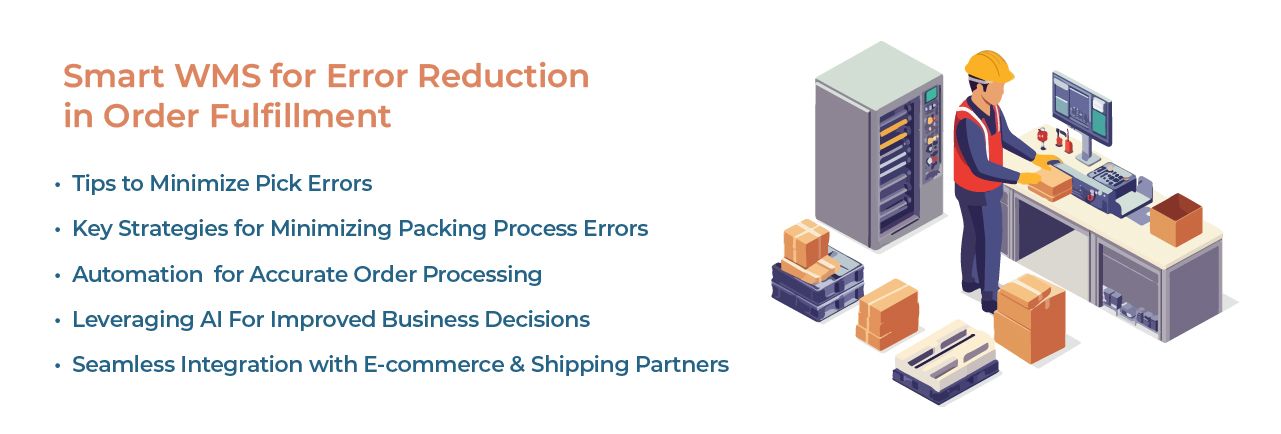An Ultimate Guide to Reducing Order Fulfillment Errors with Smart WMS
Did you know that even a small 1% order fulfillment error rate can result in thousands of incorrect orders per year for a 3PL (Third-Party Logistics), e-commerce, manufacturing, or warehousing business?
Imagine you’re eagerly waiting for a package to open but find the wrong item inside. Frustrated, you initiated a return but experienced delays and complications. Annoyed, you would not consider buying from the same store again. Fret not, you’re not alone in this situation. As per recent stats, approximately 23% of returned orders are due to the issue of delivery of incorrect items. Now, think if this mistake is made to thousands of customers, and its impact would be—lost revenue, strained customer relationships, and a tarnished brand reputation.
But what if you could reduce these errors and transform your warehouse into a well-oiled machine? This is where Smart 3PL WMS Solutions comes in. So in this article, we will discuss the common mistakes made in day-to-day operations of order fulfillment, why such mistakes happen, and how a smart Warehouse Management System (WMS) can help reduce these errors.
What do you mean by Order Fulfillment?
Order fulfillment is the comprehensive process of receiving, picking, packing, and shipping customer orders. This covers almost everything from inventory management to picking, packaging, and delivery. Businesses must have an effective fulfillment strategy to ensure timely and accurate shipments, improving customer satisfaction. Fulfillment can be managed in-house, outsourced to third-party logistics (3PL) providers, or drop-shipped for streamlined operations.
Some Common Pitfalls in Order Fulfillment You Need to Know

The order fulfillment process is intricate and mistakes can happen at any point. Here’s a rundown of the most common problems:
1. Picking & Packing Errors
Without an organized warehouse picking process, workers tend to pick the incorrect goods, resulting in inaccuracies in order fulfillment and expensive returns. Additionally, packing errors (e.g. incorrect labels to packs, damaged packages, etc.) further increase customer dissatisfaction.
2. Mismanaged Inventory
Have you ever faced an “Out of stock” situation when you thought you had enough? That's a recipe for disaster. Issues like over-selling, stockouts, or holding costs arise due to the absence of real-time inventory updates. So, if stock is not accurately tracked, inventory accuracy with WMS takes a hit resulting in sales loss and unhappy customers.
3. Insufficient Warehouse Capacity
Poor space or layout can slow operations creating bottlenecks and delays. Lack of space utilization can result in congested aisles creating inefficient workflows and delays in orders resulting in low fulfillment efficiency.
4. Lack of Automation
With manual processes, the chances of WMS error reduction failures increase, thus making it tough to ensure warehouse precision and order fulfillment accuracy. Without automation, this simple process of picking and packing can be inefficient and easily prone to errors resulting in reduced
5. Returns and Refunds Due to Errors
Every return is a cost and a potential loss of a customer. 75% of order fulfillment errors affect a high return rate and add to the operational cost increasing the negative customer trust. Wrong or defective orders can result in expensive returns or refunds, hurting your reputation and bottom line.
Smart WMS for Error Reduction in Order Fulfillment

A Warehouse Management System for 3PL is not just software; it’s your operational backbone of effective order management. A smart 3PL WMS utilizes advanced technology such as automation, AI, and real-time tracking to enhance warehouse operations, minimizes manual errors, automates processes, and improves visibility across inventory and order statuses. Here’s how it meets the challenges:
1. Tips to Minimize Pick Errors
Use a barcode scanning system throughout the warehouse as it minimizes human error ensuring fewer mistakes and detailed inventory analysis Using the latest technology such as handheld devices and voice-picking technology can improve 3PL WMS accuracy and optimize the picking environment.
Enhance slotting by sorting inventory as per demands to reduce fulfillment errors.
Consistently reevaluate and enhance picking and storage techniques that reduce wrong pickups, ultimately improving warehouse efficiency Training warehouse managers and workers with the appropriate skills also reduces WMS error reduction issues.
2. Key Strategies for Minimizing Packing Process Errors
-
Implement standardized packaging procedures and practices to enhance order fulfillment accuracy.
-
Using an automated package verification system guarantees 0 errors in order fulfillment.
-
Setting up organized packaging workstations for optimal efficiency
-
Providing clear packing instructions or documentation to packers reduces the chances of mislabeling and package errors.
-
A rigorous QA process also minimizes mistakes in order fulfillment.
3. Automation for Accurate Order Processing
Now, there is automation for 3PLs, where manual data entry is eliminated and replaced with AI-driven WMS error reductions to limit human blunders while streamlining warehouse operations.
4. Leveraging AI For Improved Business Decisions
Streamlining inventory and staffing to optimize demand planning is made possible by AI-powered forecasting, which helps in reducing fulfillment errors, helping you both accurately forecast demand and generate the optimal stock levels.
5. Seamless Integration with E-commerce & Shipping Partners
A 3PL warehouse management system should integrate with platforms like Shopify, Amazon, and top carriers, for real-time tracking and error-free fulfillment for seamless workflow.
Advantages of Implementing a Smart 3PL WMS
A smart 3PL WMS can help 3PLs reduce errors in the order fulfillment stages and help them operate more efficiently. Here are some advantages of a smart WMS:
1. Reduced Fulfillment Errors
A smart WMS automates core processes like picking, packing, and shipping, minimizing human errors. Real-time inventory tracking helps ensure inventory accuracy, thus reducing order mistakes, labor costs and increasing productivity.
2. Quicker and More Efficient Warehouse Operations
Automated systems eliminate unnecessary work processes that leave room for delays, establishing optimal workflows, improving order processing, and achieving lightning-quick speeds with a Warehouse Management System. AI-powered solutions optimize warehouse work processes, ensuring accuracy and efficiency. By mobilizing order management, order fulfillment is accelerated and resource usage is maximized.
3. Enhanced Customer Satisfaction & Retention
An intelligent WMS reduces risks and ensures accuracy in order fulfillment, which ultimately means happy customers. Well-reliable service creates long-term repeated loyalty and builds a strong brand reputation.
Real-World Success Story One of our 3PL customers in the US faced a similar problem and experienced high error rates. Within 3 months of implementing Fulfillor’s 3PL WMS software, they reduced the order fulfillment process by 25%. This is the magic of Fulfillor for 3PL logistics. FulFillor WMS is your advanced 3PL WMS that ensures inventory accuracy, thereby improving WMS error reduction.
Final Thoughts
Even a 1% decrease in order fulfillment errors can lead to substantial cost savings and customer loyalty in today’s competitive logistics landscape. Adopting an intelligent 3PL WMS like Fulfillor enables flawless order fulfillment, increased warehouse accuracy, and cost-effective fulfillment. Our smart 3PL WMS system streamlines order fulfillment, reduces error rates, and delivers faster orders.
Ready to eliminate errors and scale your 3PL business with ease? Contact us today to learn more about Fulfillor's 3PL WMS solution and how it can help you reduce order fulfillment errors and increase efficiency.
About the Author: Visvendra Singh Rajpoot is a logistics tech expert with over 5 years of experience in warehouse management solutions, helping e-commerce, retail, multi-channel, 3PL, manufacturing, and warehousing brands— including those in the US— optimize their logistics and supply chain operations, achieving operational excellence, scalability, and long-term growth.

